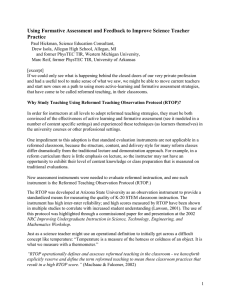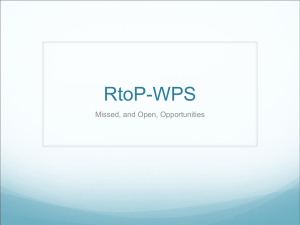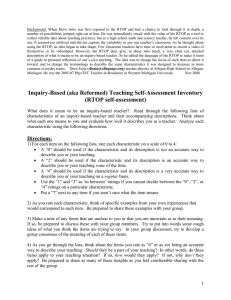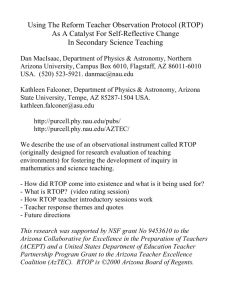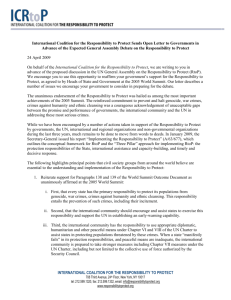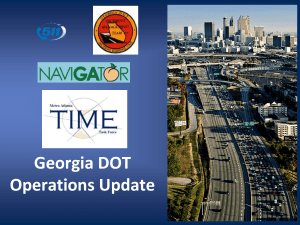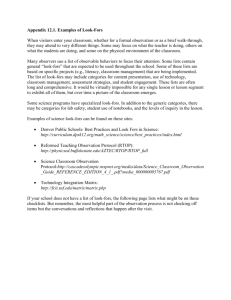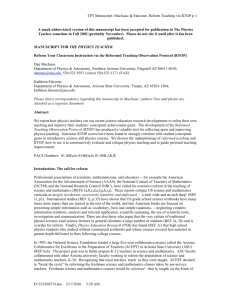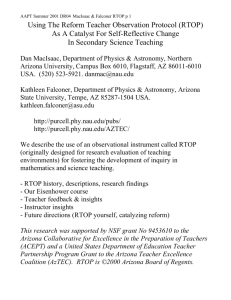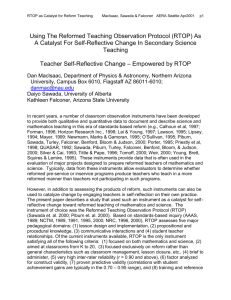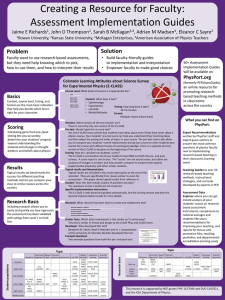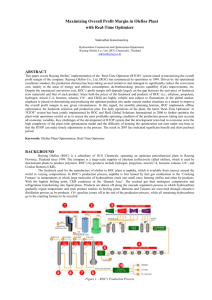Providing Feedback to Improve K-20 Science Instruction
advertisement
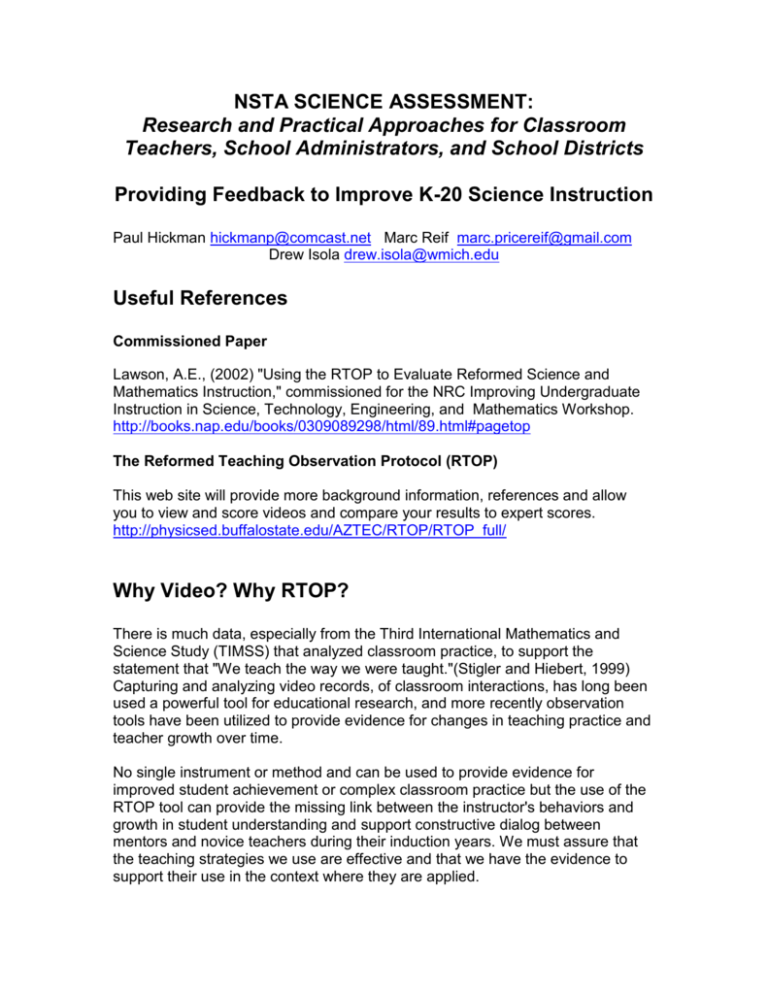
NSTA SCIENCE ASSESSMENT: Research and Practical Approaches for Classroom Teachers, School Administrators, and School Districts Providing Feedback to Improve K-20 Science Instruction Paul Hickman hickmanp@comcast.net Marc Reif marc.pricereif@gmail.com Drew Isola drew.isola@wmich.edu Useful References Commissioned Paper Lawson, A.E., (2002) "Using the RTOP to Evaluate Reformed Science and Mathematics Instruction," commissioned for the NRC Improving Undergraduate Instruction in Science, Technology, Engineering, and Mathematics Workshop. http://books.nap.edu/books/0309089298/html/89.html#pagetop The Reformed Teaching Observation Protocol (RTOP) This web site will provide more background information, references and allow you to view and score videos and compare your results to expert scores. http://physicsed.buffalostate.edu/AZTEC/RTOP/RTOP_full/ Why Video? Why RTOP? There is much data, especially from the Third International Mathematics and Science Study (TIMSS) that analyzed classroom practice, to support the statement that "We teach the way we were taught."(Stigler and Hiebert, 1999) Capturing and analyzing video records, of classroom interactions, has long been used a powerful tool for educational research, and more recently observation tools have been utilized to provide evidence for changes in teaching practice and teacher growth over time. No single instrument or method and can be used to provide evidence for improved student achievement or complex classroom practice but the use of the RTOP tool can provide the missing link between the instructor's behaviors and growth in student understanding and support constructive dialog between mentors and novice teachers during their induction years. We must assure that the teaching strategies we use are effective and that we have the evidence to support their use in the context where they are applied. Some Ways to Use RTOP To Build Collaboration Marc Reif- Cranston High School West, Cranston, R.I. As an experienced high school physics teacher, Marc was asked to mentor a recent college graduate, going through an alternative certification process, who had never taught high school before. To foster collaboration, he suggested that they observe each other using the Reformed Teaching Observation Protocol (RTOP). They were both teaching physics using the Modeling Instruction Program. Marc explained that RTOP would be a convenient way to estimate how well their classrooms exhibited the principles of reform. They sat down and discussed thoughts on the RTOP items using the training guide at one of the mentoring meetings. In the first go-round, Marc observed Mark, and then shortly afterward they reversed roles. Their RTOP scores were both reasonably high, which pleasantly surprised both of them. They had really good discussions about what was meant by the items, and what a high score on that item could mean for the students. The RTOP focused their discussions on what the students were doing in the classroom, and the reasons for the design of the lesson. Through observing each other, they became collaborators, working together to understand what each other was doing, and why. To Support Reflection on Teaching Drew Isola- PhysTEC Teacher-in-Residence, Western Michigan University When Drew was first exposed to the RTOP, and had a chance to look through it in depth, a number of possibilities jumped right out at him. He was immediately struck with the value of the RTOP as a tool to collect reliable data about teaching practices but as a high school math and science teacher, felt an immediate concern over use of such an instrument. It seemed too artificial and did not capture the variability in any one teacher’s classroom. So, the more he thought about using the RTOP, a third idea began to take shape. Very few classroom teachers have the time or motivation to record video of themselves or be videotaped. However, the RTOP does give, to those who teach, a very clear cut, detailed description of what it means to be an inquiry-based teacher. He took the RTOP and edited the language of the instrument to make it more of a guide to personal reflection of one’s own teaching. The idea was to change the focus of each item so they were directed inward and to change the terminology so that it was describing the same characteristics it was designed to measure in more common everyday terms. To Change Teacher's Ideas about Teaching and Learning Science Dan MacIsaac and Kathleen Falconer, SUNY-Buffalo State College At Dan and Kathleen’s institution, a series of reform-centered physics courses are taught to pre-service and in-service teachers. The courses feature extended student discourse with research-developed, guided discovery learning and metacognitively supported curricula. The courses are often the first exposure participants have with reformed teaching, and the students struggle with scientific inquiry and discourse, group warranting of scientific knowledge and a lack of memorization. At the start of these courses many students have difficulty making sense of their experiences and show a lack of faith in their own ability to reason scientifically. In the undergraduate courses for pre-service teachers, students are asked to react to a single item from RTOP illustrating their response with an example directly from their own classroom experiences. This helps to develop their ability to critically appraise both their teaching and to reflect upon their own learning. Experienced teachers taking the courses have a different assignment: they are asked to write a pre-arrival paper in which they discuss what they feel good teaching looks like, how their own teaching falls into this description and provide an example from their own experience. At the end of the course all teachers are asked to reflect on how their definition of what good teaching looks like has changed during the course. To Develop an Understanding of Inquiry Joseph J. Bellina, Jr., Saint Mary’s College Joe developed and led weeklong workshops designed to engage K-6 teachers in learning by grade-level appropriate guided inquiry. Each morning teachers learned science by guided inquiry using materials designed for adults. Each afternoon they observed, practiced, and discussed teaching science by guided inquiry using materials designed for grades K-6. The RTOP instrument and training videos were used to bring closure to the week. The teachers read the guidelines and descriptions of the RTOP items during the evening before the final day of the workshop. Since the teachers had been immersed in guided inquiry instruction for the four previous days, the language and expectations presented were familiar. On the afternoon of the last day, the teachers observed the training videos, rated the teacher performance, discussed their ratings with a partner and then reported scores orally. A histogram of the results was created and compared with the expert score and discussed as a group. The RTOP experience was so successful that the school district agreed to use an edited list (to reduce the number of items) as the basis for the observation protocol that would be used to evaluate the results of the collaboration. To Introduce TAs to Reformed Instruction Nicholas A. Gross- Northeastern University, Boston, MA Nick used the RTOP materials as a way to introduce instructors, particularly graduate students, to the delivery of a novel general science curriculum developed by the Embedded Learning Modules (ELMO) project at Northeastern University. ELMO courses use a highly interactive classroom environment where students actively explore natural phenomena and engage in discussions with the instructor and other students. The RTOP training materials provide a common and rich reference experience with research-based instructional vocabulary. This supports new and experienced instructors as they begin discussing the value of the instructional model used in ELMO. Instructors viewed RTOP training videos, rated them with the RTOP instrument and then discussed the ratings for each item as a group. As they learn and deliver the interactive curriculum, the work with RTOP provides a common language for them to discuss issues with more experienced instructors. In this way, new instructors not only gain experience teaching a novel curriculum, but they also have a set of principles and vocabulary provided by RTOP to evaluate that experience. To Document Change in Teaching Practice Paul Hickman- Consultant, PhysTEC Project Paul led a workshop called "Quantifying Classroom Instruction with RTOP" for secondary math coaches from CESAME's Massachusetts Mathematics Coaching Project. Our workshop was designed to: Develop an awareness for the RTOP as a research tool; practice using RTOP in a collegial supportive environment; improve objective observational expertise; and increase understanding of the meaning of the 25 RTOP items. Participants refined their ability to use the tool by watching video of mathematics teachers, recording their observations individually, quantifying their observations using the rubric, discussing and justifying the scores to a partner and then coming to a group consensus on their RTOP scores. They then compared their consensus score to the expert score. The tool was needed measure and document changes in teacher classroom practice as a result of the ongoing coaching interventions. Stephanie Feger from the Education Alliance at Brown University, who attended the workshop, is now using RTOP observations with her colleagues to provide baseline measures of mathematics teacher behaviors in Florida.
